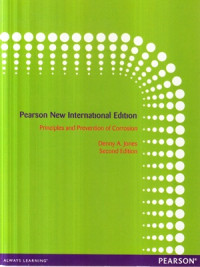Text
Principles and prevention of corrosion
The title of this book was chosen to reflect a blend of science (principles) and engi¬neering (prevention) in the study of metal corrosion. The instructor or the student can pick and choose between principles and prevention to obtain a blend that satis¬fies his or her background and interests. The book is planned so that the instructor can easily design a course at any desired level—or so that an individual can pick the book up and easily read selected sections to get a quick introduction to the subject. In general, most chapters progress from qualititative, descriptive sections, including methods of prevention and testing, to more quantitative sections, involving metal¬lurgy and electrochemistry, and finally to the later sections on current research and the latest knowledge of the chapter topic. Thus, the casual reader or serious student can progress in a given chapter to any desired level.
The essentials of a senior/graduate level course are contained in the book, which deliberately contains more information than can be included in a fifteen-week semester. Most chapters include material beyond that which need be treated in an introductory course. Thus, the book can provide at least the starting point for a more-advanced graduate-level course as well. The additional material also adds a valuable component for future reference by practicing engineers, whether or not they may have taken a formal academic course in corrosion. I have included material that I have wished during my career could have been included in my first course on cor-rosion or had been available for concise reference along the way.
An understanding of the principles of electrochemistry is recommended to pro¬vide students with the tools to deal with diverse problems of analysis and preven¬tion. However, the essential elements of electrochemical corrosion are presented in Chapter 1, and the more engineering-oriented instructor could easily omit the added detail of Chapters 2, 3, and 4, concentrating subsequently on the engineering aspects of corrosion testing and prevention.
The book does not provide encyclopedic coverage for the subject of corrosion and corrosion prevention. The emphasis is on the principles and methods leading to reasonable mitigation of the great majority of corrosion problems in engineering practice. Thus, the book is designed to be useful as a text for formal university engi¬neering courses at the senior/first year graduate level and as a reference for the neo¬phyte, the practicing engineer, or the beginning researcher. A primary reference within this book is the recent Metals Handbook, Volume 13, Corrosion, 9th ed., pub¬lished by ASM International, which is recommended as a supplement.
Ketersediaan
Informasi Detail
- Judul Seri
-
-
- No. Panggil
-
620.112 Jon p
- Penerbit
- London : Pearson., 2014
- Deskripsi Fisik
-
xvi. 578 hal. : il. ; 23 cm.
- Bahasa
-
English
- ISBN/ISSN
-
9781292042558
- Klasifikasi
-
620.112
- Tipe Isi
-
-
- Tipe Media
-
-
- Tipe Pembawa
-
-
- Edisi
-
Ed. II
- Subjek
- Info Detail Spesifik
-
-
- Pernyataan Tanggungjawab
-
-
Versi lain/terkait
Tidak tersedia versi lain
Lampiran Berkas
Komentar
Anda harus masuk sebelum memberikan komentar

 Karya Umum
Karya Umum  Filsafat
Filsafat  Agama
Agama  Ilmu-ilmu Sosial
Ilmu-ilmu Sosial  Bahasa
Bahasa  Ilmu-ilmu Murni
Ilmu-ilmu Murni  Ilmu-ilmu Terapan
Ilmu-ilmu Terapan  Kesenian, Hiburan, dan Olahraga
Kesenian, Hiburan, dan Olahraga  Kesusastraan
Kesusastraan  Geografi dan Sejarah
Geografi dan Sejarah